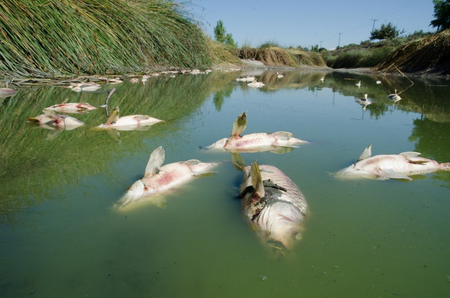399. Behavioural economics + production economics = impact
Behavioural economists are studying “nudges” to prompt behaviour change in agriculture. Accounting for production economics can help make nudges more impactful.
Much of the early work in behavioural economics focused on consumers, with less attention paid to producers. Now there is growing attention being paid to farmers (e.g., see reviews by Byerly et al., 2018, Balmford et al., 2021, Palm-Forster and Messer, 2022), complementing the existing body of research on farmers’ adoption of new practices and technologies (Pannell et al. 2006).
 With my collaborators Yuan Chai and Phil Pardey from the University of Minnesota, I have just published a paper on using nudges to try to get farmers to reduce their usage of nitrogen fertilizer, in order to reduce water pollution in bodies of water where the nutrients end up (Chai et al. 2023). The key point of the paper is that if we recognise some important empirical results related to the production economics of nitrogen fertilizer, we can probably target nudges in ways that will make them more likely to succeed.
With my collaborators Yuan Chai and Phil Pardey from the University of Minnesota, I have just published a paper on using nudges to try to get farmers to reduce their usage of nitrogen fertilizer, in order to reduce water pollution in bodies of water where the nutrients end up (Chai et al. 2023). The key point of the paper is that if we recognise some important empirical results related to the production economics of nitrogen fertilizer, we can probably target nudges in ways that will make them more likely to succeed.
Looking at the existing papers on the use of nudges in agriculture, I don’t see this sort of thinking in evidence. That could be part of the reason why the measured impacts of nudges in agriculture so far have often been pretty small. I suspect that nudges have often been used to promote behaviours that are not very “nudgeable”. Carlsson et al. (2021) argued that, for a nudge to work, the target behavior needs to be “nudgeable”, meaning that the utility (or expected profit) difference between the behavioral options is not large. In other words, adoption of the target behaviour needs to be not too expensive to the adopter.
In our paper we highlight several insights from production economics that are relevant to this. These are that, a) many farmers apply higher rates of N fertilizer than would maximize their own private interests, b) N fertilizer is a not risk-reducing input, and c) the relationship between N rate and profit is flat over a range of N rates. Of these three insights, the first is widely recognized but the second and third are not. Indeed, we anticipate that many farmers and some farm advisers will need to be convinced that the three results presented above are in fact true. Fortunately, there is clear empirical evidence that can potentially be utilized in nudges to influence the behavior of farmers.
We make specific suggestions for ways in which behavioral science could contribute in these areas, including understanding farmers’ perceptions about nitrogen, yield and profit (detecting biases), understanding the influences of these biases on behavior, understanding farmers’ perceptions of and preferences for different policy responses, and designing behavioral nudges that capitalize on the specific insights we have highlighted regarding the production economics of nitrogen fertilizer. Nudges could include strategies that aim to correct biases in perceptions (e.g., about yield increases or risk reductions from applying N), or tap into social and psychological factors that influence farmers’ decision making.
I think the general approach of targeting nudges to behaviours that are judged to be nudgeable has a lot of merit. It’s basically the same as the argument I’ve made for years that extension should focus on trying to increase adoption of practices in circumstances where those practices are adoptable.
The paper is open access until October 20, 2023 here: https://authors.elsevier.com/a/1hgyx15oGpGm2N
Further reading
Balmford, A., R.B. Bradbury, J.M. Bauer, S. Broad, G. Burgess, M. Burgman, H. Byerly, S. Clayton, D. Espelosin, P. Ferraro, B. Fisher, E.E. Garnett, (2021). Making more effective use of human behavioural science in conservation interventions, Biological Conservation 261, Article 109256.
Byerly, H., A. Balmford, P.J. Ferraro, C.H. Wagner, E. Palchak, S. Polasky, T.H. Ricketts, A.J. Schwartz, B. Fisher, (2018). Nudging pro-environmental behavior: evidence and opportunities, Frontiers in Ecology and the Environment 16(3), 159-168.
Carlsson, F., C. Gravert, O. Johansson-Stenman, V. Kurz (2021). The use of green nudges as an environmental policy instrument, Review of Environmental Economics and Policy 15(2), 216-237.
Chai, Y., Pannell, D.J. and Pardey, P. (2023). Nudging farmers to reduce water pollution from nitrogen fertilizer, Food Policy 120, 102525. https://authors.elsevier.com/a/1hgyx15oGpGm2N
Palm-Forster, L., Messer, K., 2022. Behavioral and experimental economics to inform agri-environmental programs and policies. Chapter 6 in Handbook of Agricultural Economics volume 5, Barrett, C.B., Just, D.R. (Eds.), Elsevier, Amsterdam.
Pannell, D.J., Marshall, G.R., Barr, N., Curtis, A., Vanclay, F. and Wilkinson, R. (2006). Understanding and promoting adoption of conservation practices by rural landholders. Australian Journal of Experimental Agriculture 46(11), 1407-1424.